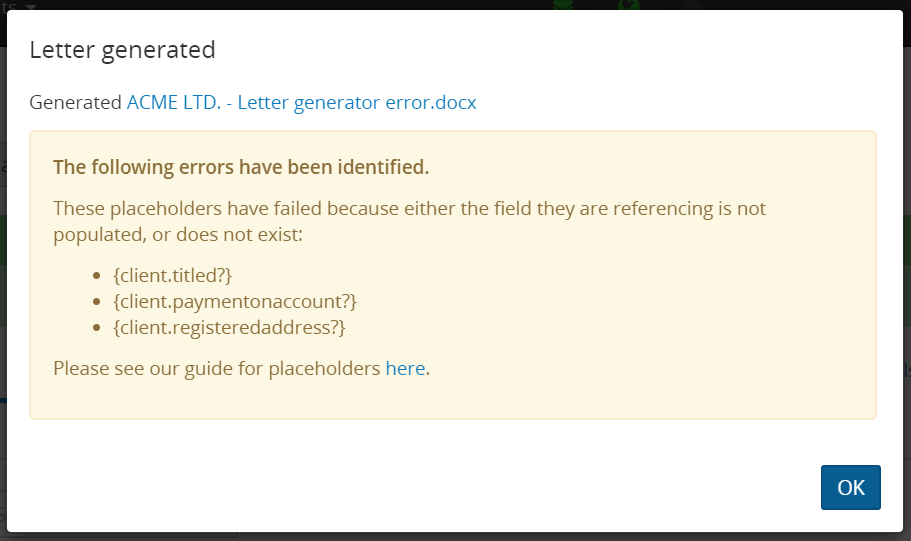Generate documents
You can store template documents and generate personalised versions to send to your clients. This process adds relevant information from the client's record, such as their company name and address.
Step 1: Create your DOCX file
Create your document externally to Senta in the document editor of your choice. If you want to populate your document with client information or services, you must use specific placeholders.
Placeholders for client information:
Here are some commonly used placeholders:
-
Client name
-
{client.title}
-
-
Primary contact information
-
{client.contact1.firstname} {client.contact1.lastname}
-
-
Secondary/other contact information
-
{client.contact2.firstname} {client.contact3.lastname}.
You can choose which contact is referred to by changing the number in "contact1" e.g. for the 2nd contact for a client, using "contact2".
-
-
Address
-
{client.address1} {client.address2} {client.town} {client.district} {client.postcode}
-
Address where each field is on a new line
-
-
Address where each field is on a new line
-
{client.address1 | newline}{client.address2 | newline}{client.district | newline}{client.town | newline}{client.postcode | newline}
-
If you have added extra address fields or if you are based outside the UK, the field references for address information may be different. You can always check the field references for the address fields by going to Settings > Forms > Client details > Address tab.
Placeholders for services
To retrieve a list of services offered to a client into an email, use the following formatting:
-
{each(service)}
- {service.title}
{service.sales | optional}
{service.terms | optional}
{if(service.fees.setup)} £{service.fees.setup} setup {endif}
{if(service.fees.monthly)} £{service.fees.monthly} each month {endif}
{if(service.fees.annual)} £{service.fees.annual} per year {endif}
{endeach}
-
{service.sales} refers to the "sales description" field on any service
-
{service.terms} refers to the "sales terms" field on any service
-
{services.fees.setup} refers to the "setup fee" field on any service
-
{services.fees.monthly} refers to the "monthly fee" field on any service
-
{services.fees.annual} refers to the "annual fee" field on any service
These fields can be switched on via Settings > General Settings > Extras.
The each function means that Senta will look for the title, sales and terms for each service, and pull that information into an email.
Ensure you save your document in docx format, as this is the only type of document compatible with Senta's letter generator.
Step 2: Upload your document to Senta
Upload your template document to your practice documents.
-
Go to Documents > Practice documents.
-
Select Upload and either drag and drop the document you just created into the window.
Step 3: Generate your document
-
Go to the client record you want to generate the document for and select More actions > Generate letter.
-
Select your template document from practice documents and select OK. Senta will automatically create the document and add it to the client's Documents tab.
-
You can either download a copy, or set the visibility for your client to view the document from the portal.
Senta does not currently support previews of DOCX files.
Letter generator placeholder error warning
If you have used placeholders in your template document that are not populated or do not exist, Senta will let display the ones causing the problem in a message:

You will need to review the placeholders in your template document and also ensure that the relevant fields are populated on the client.